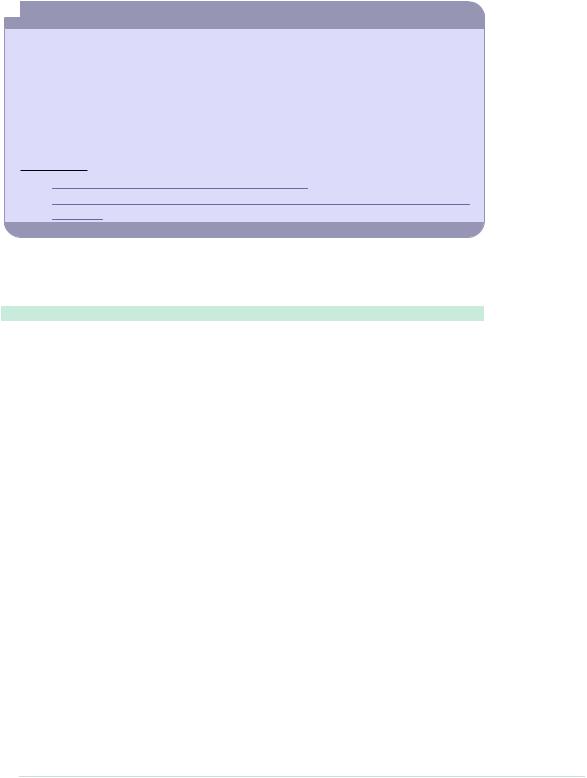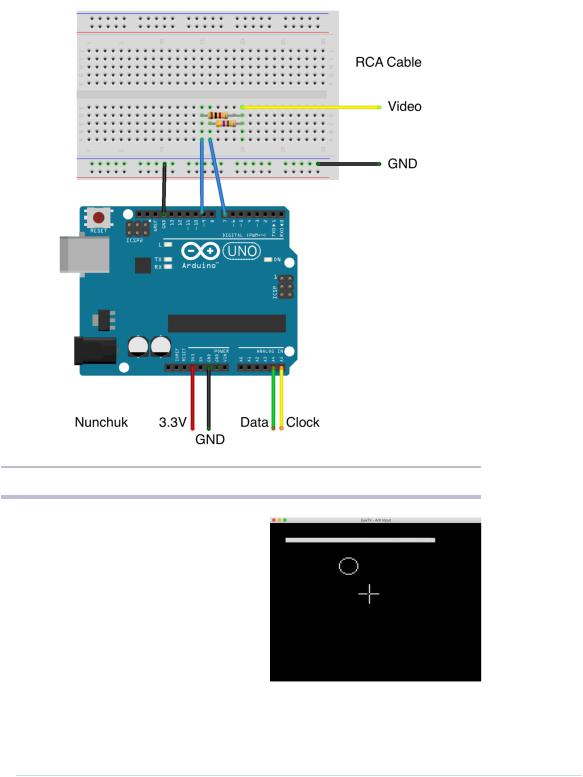
- •Acknowledgments
- •Preface
- •Who Should Read This Book
- •What’s in This Book
- •Arduino Uno and the Arduino Platform
- •Code Examples and Conventions
- •Online Resources
- •The Parts You Need
- •Starter Packs
- •Complete Parts List
- •1. Welcome to the Arduino
- •What You Need
- •What Exactly Is an Arduino?
- •Exploring the Arduino Board
- •Installing the Arduino IDE
- •Meeting the Arduino IDE
- •Hello, World!
- •Compiling and Uploading Programs
- •What If It Doesn’t Work?
- •Exercises
- •2. Creating Bigger Projects with the Arduino
- •What You Need
- •Managing Projects and Sketches
- •Changing Preferences
- •Using Serial Ports
- •What If It Doesn’t Work?
- •Exercises
- •3. Building Binary Dice
- •What You Need
- •Working with Breadboards
- •Using an LED on a Breadboard
- •First Version of a Binary Die
- •Working with Buttons
- •Adding Your Own Button
- •Building a Dice Game
- •What If It Doesn’t Work?
- •Exercises
- •4. Building a Morse Code Generator Library
- •What You Need
- •Learning the Basics of Morse Code
- •Building a Morse Code Generator
- •Fleshing Out the Morse Code Generator’s Interface
- •Outputting Morse Code Symbols
- •Installing and Using the Telegraph Class
- •Publishing Your Own Library
- •What If It Doesn’t Work?
- •Exercises
- •5. Sensing the World Around Us
- •What You Need
- •Measuring Distances with an Ultrasonic Sensor
- •Increasing Precision Using Floating-Point Numbers
- •Increasing Precision Using a Temperature Sensor
- •Creating Your Own Dashboard
- •What If It Doesn’t Work?
- •Exercises
- •What You Need
- •Wiring Up the Accelerometer
- •Bringing Your Accelerometer to Life
- •Finding and Polishing Edge Values
- •Building Your Own Game Controller
- •More Projects
- •What If It Doesn’t Work?
- •Exercises
- •7. Writing a Game for the Motion-Sensing Game Controller
- •Writing a GameController Class
- •Creating the Game
- •What If It Doesn’t Work?
- •Exercises
- •8. Generating Video Signals with an Arduino
- •What You Need
- •How Analog Video Works
- •Building a Digital-to-Analog Converter (DAC)
- •Connecting the Arduino to Your TV Set
- •Using the TVout Library
- •Building a TV Thermometer
- •Working with Graphics in TVout
- •What If It Doesn’t Work?
- •Exercises
- •9. Tinkering with the Wii Nunchuk
- •What You Need
- •Wiring a Wii Nunchuk
- •Talking to a Nunchuk
- •Building a Nunchuk Class
- •Using Our Nunchuk Class
- •Creating Your Own Video Game Console
- •Creating Your Own Video Game
- •What If It Doesn’t Work?
- •Exercises
- •10. Networking with Arduino
- •What You Need
- •Using Your PC to Transfer Sensor Data to the Internet
- •Registering an Application with Twitter
- •Tweeting Messages with Processing
- •Communicating Over Networks Using an Ethernet Shield
- •Using DHCP and DNS
- •What If It Doesn’t Work?
- •Exercises
- •11. Creating a Burglar Alarm with Email Notification
- •What You Need
- •Emailing from the Command Line
- •Emailing Directly from an Arduino
- •Detecting Motion Using a Passive Infrared Sensor
- •Bringing It All Together
- •What If It Doesn’t Work?
- •Exercises
- •What You Need
- •Understanding Infrared Remote Controls
- •Grabbing Remote Control Codes
- •Cloning a Remote
- •Controlling Infrared Devices Remotely with Your Browser
- •Building an Infrared Proxy
- •What If It Doesn’t Work?
- •Exercises
- •13. Controlling Motors with Arduino
- •What You Need
- •Introducing Motors
- •First Steps with a Servo Motor
- •Building a Blaminatr
- •What If It Doesn’t Work?
- •Exercises
- •Current, Voltage, and Resistance
- •Electrical Circuits
- •Learning How to Use a Wire Cutter
- •Learning How to Solder
- •Learning How to Desolder
- •The Arduino Programming Language
- •Bit Operations
- •Learning More About Serial Communication
- •Serial Communication Using Various Languages
- •What Are Google Chrome Apps?
- •Creating a Minimal Chrome App
- •Starting the Chrome App
- •Exploring the Chrome Serial API
- •Writing a SerialDevice Class
- •Index

Chapter 9. Tinkering with the Wii Nunchuk • 152
 Scientific Applications Using Wii Equipment
Scientific Applications Using Wii Equipment
Because of the Wii’s accuracy and low price, many scientists use the Wii for things other than gaming. Some hydrologists use it for measuring evaporation from a body of water.a Usually, you’d need equipment costing more than $500 to do that.
Some doctors at the University of Melbourne had a closer look at the Wii Balance Board, because they were looking for a cheap device to help stroke victims recover.b
They published a scientific paper verifying that the board’s data is clinically comparable to that of a lab-grade “force platform” for a fraction of the cost.
a.http://www.wired.com/wiredscience/2009/12/wiimote-science/
b.http://www.newscientist.com/article/mg20527435.300-wii-board-helps-physios-strike-a-balance-after- strokes.html
Using Our Nunchuk Class
Let’s use the Nunchuk class to see what data the controller actually returns:
Tinkering/NunchukDemo/NunchukDemo.ino
#include <Wire.h> #include "nunchuk.h"
const unsigned int BAUD_RATE = 19200; Nunchuk nunchuk;
void setup() { Serial.begin(BAUD_RATE); nunchuk.initialize();
}
void loop() {
if (nunchuk.update()) { Serial.print(nunchuk.joystick_x()); Serial.print(" "); Serial.print(nunchuk.joystick_y()); Serial.print(" "); Serial.print(nunchuk.x_acceleration()); Serial.print(" "); Serial.print(nunchuk.y_acceleration()); Serial.print(" "); Serial.print(nunchuk.z_acceleration()); Serial.print(" "); Serial.print(nunchuk.z_button()); Serial.print(" "); Serial.println(nunchuk.c_button());
}
}
report erratum • discuss

Creating Your Own Video Game Console • 153
No big surprises here: we define a global Nunchuk object and initialize it in the setup function. In loop, we call update to request the controller’s current status and output all attributes to the serial port.
Compile and upload the program, and then open the serial monitor and play around with the Nunchuk. Move the stick, move the controller, and press the buttons, and you should see something like this:
46 109 428 394 651 1 1
49 132 414 380 656 1 0
46 161 415 390 651 1 0
46 184 429 377 648 1 0
53 199 404 337 654 1 0
53 201 406 359 643 1 0
You have successfully connected a Nunchuk controller to your Arduino. It really isn’t rocket science, and in the next section you’ll learn how to use it to control your own video games.
The next time you buy a new piece of hardware, try to imagine how to use it in a different context. Often it’s easier than you think. Oh, and whenever you create a class such as our Nunchuk class, consider turning your code into a library and making it available on the Internet. (See Chapter 4, Building a Morse Code Generator Library, on page 61, to learn how to create your own libraries.)
Creating Your Own Video Game Console
Now that you know how to generate video output and how to control the Wii Nunchuk, it seems natural to build your own little video game console. You only have to combine the Nunchuk circuit and the circuit for generating the video signal. See Figure 27, Circuit of our video game console, on page 154.
Note that you still don’t need a breadboard. Simply connect the Nunchuk to the Arduino as shown on page 146 and connect the RCA cable as shown on page 133. That’s all you have to do to create your own video game console. Now let’s write some games for it.
Creating Your Own Video Game
TVout and our Nunchuk library are all we need to write entertaining games for our video game console. In this section we’ll build Pragduino, a simple game that demonstrates most of the skills you need to write more complex games.
report erratum • discuss

Chapter 9. Tinkering with the Wii Nunchuk • 154
Figure 27—Circuit of our video game console
The player controls crosshairs using the Nunchuk’s analog stick and has to shoot circles using the Nunchuk’s Z button. The circles appear at random positions and stay there for 1.5 seconds. A status bar at the top of the screen shows how much time is left until the current circle disappears. The game ends after ten rounds, and the game’s goal is to hit as many circles as possible.
report erratum • discuss

Creating Your Own Video Game • 155
Before we dive into the game’s code, make sure you’ve installed the TVout library as described in Using the TVout Library, on page 133. You also have to make the code of your Nunchuk library available. We haven’t turned it into a complete library in this chapter, but the book’s code archive contains an enhanced version. Download the book’s code from the book’s website and unzip it. Copy the code/Tinkering/Nunchuk directory to the libraries folder of your Arduino IDE. Alternatively, you can create a folder named Nunchuk in your IDE’s libraries folder and copy the nunchuk.h and nunchuk.cpp files to it. In both
cases you have to restart the IDE.
That’s all the preparation you need to implement the Pragduino game, so let’s get started.
|
Setting the Stage for the Game |
|
Most games need to handle a lot of global state, and Pragduino is no exception, |
|
so its code starts with a list of constant and variable definitions: |
|
Tinkering/Pragduino/Pragduino.ino |
|
#include <Wire.h> |
|
#include <TVout.h> |
|
#include <fontALL.h> |
|
#include "nunchuk.h" |
|
const int WIDTH = 128; |
|
const int HEIGHT = 96; |
|
const int CH_LEN = 8; |
|
const int MAX_TARGET = 10; |
|
const int TARGET_LIFESPAN = 1500; |
|
As usual, we include all header files we need and define a few constants. |
|
WIDTH and HEIGHT contain the screen dimensions, and CH_LEN contains the |
|
length of a single crosshair element. (The crosshairs consist of four elements.) |
|
MAX_TARGET contains the number of circles you have to shoot, and TARGET_LIFESPAN |
|
contains a circle’s lifespan measured in milliseconds. |
|
Next we define several global variables: |
|
Tinkering/Pragduino/Pragduino.ino |
Line 1 |
TVout tv; |
- |
Nunchuk nunchuk; |
- |
|
- |
boolean up, down, left, right, c_button, z_button; |
5 |
int chx, chy; |
-int chvx, chvy;
-int target_x, target_y, target_r;
-unsigned int target_count;
-unsigned int hits;
report erratum • discuss

Chapter 9. Tinkering with the Wii Nunchuk • 156
10 unsigned long target_creation;
-
-enum GameState {
-INTRO, STARTING, RUNNING, DONE
-};
15
- GameState state;
In game programming you often have to manage a lot of global variables—even in a small game like ours. First, we define a TVout instance named tv and a Nunchuk instance named nunchuk. After that, we define Boolean variables for all Nunchuk properties we’re interested in. They all work the same—we set up to true, for example, if the user pushes the Nunchuk’s analog stick upward.
chx and chy contain the current position of the crosshairs. chvx and chvy contain its X and Y velocity. Similarly, target_x and target_y contain the position of the current target. Because the target is a circle, we also need a radius, which we store in target_r.
target_count contains the number of targets we’ve created already, and in hits you can find the number of targets the player has hit so far. Targets disappear automatically after a short period of time, so we need a place to store the creation time of the current target. This place is target_creation.
In line 12, we define an enumeration that lists our game’s potential states. If the game is in the INTRO state, it displays a title screen and waits for the player to press the Z button. If the player presses the Z button, the game changes to the STARTING state. It outputs a “READY?” message and waits for another button press to give the player some time to prepare.
The RUNNING state is where all the action is. In this state the game loop creates new targets, checks the player’s moves, and so on. After all targets have appeared, the game state changes to DONE. The player will see a game-over screen and the number of targets that he or she has hit.
We need to initialize all of these global variables whenever a new game starts. The following functions will do that:
Tinkering/Pragduino/Pragduino.ino void init_game() {
up = down = left = right = c_button = z_button = false; chx = WIDTH / 2;
chy = HEIGHT / 2; chvx = 1;
chvy = 1; state = INTRO;
target_count = 0;
report erratum • discuss

Creating Your Own Video Game • 157
hits = 0; create_target();
}
void create_target() { target_r = random(7, 11);
target_x = random(target_r, WIDTH - target_r); target_y = random(target_r, HEIGHT - target_r); target_count++;
target_creation = millis();
}
The init_game function sets most of the global variables to constant values. create_target is a bit more interesting. It creates a new target at a random position and having a random size. We’ll use it later on in the game loop whenever we need to create a new target. Note that the function ensures that the target always stays within the screen’s bounds. Also, it uses the millis function to determine the target’s creation time.
Adding the Setup and Loop Functions
Like all Arduino programs our little game needs setup and loop functions:
Tinkering/Pragduino/Pragduino.ino
Line 1 void setup() {
-randomSeed(analogRead(A0));
-tv.begin(PAL, WIDTH, HEIGHT);
-nunchuk.initialize();
5init_game();
- |
} |
- |
|
-void loop() {
-check_controls(); 10 switch (state) {
- |
case |
INTRO: |
intro(); |
break; |
- |
case |
STARTING: |
start_game(); |
break; |
-case RUNNING: update_game(); break;
- |
case DONE: |
game_over(); |
break; |
15 |
} |
|
|
-tv.delay_frame(1);
-}
-
- void check_controls() {
20 up = down = left = right = c_button = z_button = false;
-if (nunchuk.update())
-{
-if (nunchuk.joystick_x() < 70)
-left = true;
25 if (nunchuk.joystick_x() > 150) - right = true;
report erratum • discuss

Chapter 9. Tinkering with the Wii Nunchuk • 158
-if (nunchuk.joystick_y() > 150)
-up = true;
-if (nunchuk.joystick_y() < 70) 30 down = true;
-c_button = nunchuk.c_button();
-z_button = nunchuk.z_button();
-}
-}
setup initializes the random number generator using some noise from analog
pin A0. Then it initializes the screen and the Nunchuk, and finally it calls init_game to set all global variables to reasonable values.
The loop function calls check_controls to read the current state of the Nunchuk. Then it checks the game’s current state in a switch statement and delegates its work to the function responsible for handling the current state.
In line 16, loop calls a function of the TVout library you haven’t seen before. delay_frame waits for the beginning of the next vertical blanking interval—that is, for the moment when the TV set’s electron beam wanders from the bottom of the screen back to the top. We only want to wait for the beginning of the next frame, so we pass 1 to delay_frame. This is necessary to prevent flickering, because it ensures that the creation of the game’s graphics in memory stays in sync with the actual output on the screen.
Handling the Different Game States
Handling the game’s different states is vital, so we define separate functions for dealing with each game state:
Tinkering/Pragduino/Pragduino.ino
Line 1 void intro() {
-tv.select_font(font8x8);
-tv.printPGM(28, 20, PSTR("Pragduino"));
-tv.select_font(font6x8);
5tv.printPGM(16, 40, PSTR("A Pragmatic Game"));
-tv.select_font(font4x6);
-tv.printPGM(18, 74, PSTR("Press Z-Button to Start"));
-if (z_button) {
-state = STARTING;
10 z_button = false;
-delay(200);
-}
-}
-
15 void start_game() {
-tv.clear_screen();
-tv.select_font(font8x8);
-tv.printPGM(40, 44, PSTR("READY?"));
report erratum • discuss

Creating Your Own Video Game • 159
-if (z_button) {
20 init_game();
-state = RUNNING;
-}
-}
-
25 void game_over() {
-tv.clear_screen();
-tv.select_font(font8x8);
-tv.printPGM(28, 38, PSTR("Game Over"));
-int x = (WIDTH - 7 * 8) / 2;
30 if (hits > 9)
-x = (WIDTH - 8 * 8) / 2;
-tv.printPGM(x, 50, PSTR("Hits: "));
-tv.print(x + 6 * 8, 50, hits);
-if (z_button) {
35 state = STARTING;
-z_button = false;
-delay(200);
-}
-}
40
-void update_game() {
-tv.clear_screen();
-tv.draw_circle(target_x, target_y, target_r, WHITE);
-move_crosshairs();
45 draw_crosshairs();
-check_target();
-if (target_count == MAX_TARGET + 1) {
-state = DONE;
-z_button = false;
50 delay(200);
-}
-}
The intro, start_game, and game_over functions are very similar. They print a message to the screen, then they wait for a Z button press. If the Z button was pressed, they move to the next state. Before they move to the next state, they set z_button to false and wait for 200 milliseconds. This is necessary to debounce the Z button.
All three functions use yet another TVout method. Look at line 3, for example. Here we use TVout’s printPGM method. It works like the regular print method, but it reads the string to be output from the Arduino’s flash memory and not from its precious SRAM. For applications that display a lot of constant messages, this can save a lot of memory.
report erratum • discuss

Chapter 9. Tinkering with the Wii Nunchuk • 160
To transfer the string into flash memory, we use the PSTR macro. It ensures that the strings we output using printPGM will be copied to flash memory when the program gets compiled.
Writing the Game Loop
The most central function of our game is update_game. It implements the actual game loop and first clears the screen by calling clear_screen. Then it uses draw_circle to draw the current target. move_crosshairs calculates the new position of the crosshairs depending on the player’s movement. draw_crosshairs outputs the crosshairs to the screen.
check_target determines the state of the current target—in other words, it checks whether the user has hit the target, whether the target has been on the screen for too long, or whether nothing special has happened. If all targets have been shown already, the game is over.
To control the crosshairs, we use the following helper functions:
Tinkering/Pragduino/Pragduino.ino void move_crosshairs() {
if (left) chx -= chvx; if (right) chx += chvx; if (up) chy -= chvy; if (down) chy += chvy;
if (chx <= CH_LEN) chx = CH_LEN + 1;
if (chx >= WIDTH - CH_LEN) chx = WIDTH - CH_LEN - 1;
if (chy <= CH_LEN) chy = CH_LEN + 1;
if (chy >= HEIGHT - CH_LEN) chy = HEIGHT - CH_LEN - 1;
}
void draw_crosshairs() {
tv.draw_row(chy, chx - CH_LEN, chx - 1, WHITE); tv.draw_row(chy, chx + 1, chx + CH_LEN, WHITE); tv.draw_column(chx, chy - CH_LEN, chy - 1, WHITE); tv.draw_column(chx, chy + 1, chy + CH_LEN, WHITE);
}
move_crosshairs checks all global variables related to the current Nunchuk state. It updates the position of the crosshairs depending on the variable values. Then it ensures that the crosshairs stay within the screen’s bounds.
report erratum • discuss

Creating Your Own Video Game • 161
The draw_crosshairs function actually draws the crosshairs on the screen. Instead of using a bitmap to draw the crosshairs, we use two new TVout methods. draw_row outputs a horizontal line, and we use it to output the two horizontal lines of the crosshairs. Similarly, we use draw_column to draw the two vertical lines. We leave the pixel at the crossing point empty to make the crosshairs look a bit nicer.
You might wonder why we didn’t use a bitmap. The problem with bitmaps is that they don’t look nice when they overlap. Even if the bitmap looks like crosshairs, it still is a square. If you move a crosshairs bitmap over a circle, the bitmap will hide a big part of the circle’s pixels.
To complete the game’s source code, we need two functions for managing the targets:
Tinkering/Pragduino/Pragduino.ino bool target_hit() {
if (z_button)
return (target_x - chx) * (target_x - chx) +
(target_y - chy) * (target_y - chy) < target_r * target_r; return false;
}
void check_target() { if (target_hit()) {
hits++; create_target();
}
int remaining_time = millis() - target_creation; if (remaining_time >= TARGET_LIFESPAN) {
create_target();
}
int w = map(TARGET_LIFESPAN - remaining_time, 0, TARGET_LIFESPAN, 0, WIDTH); tv.draw_rect(0, 0, w, 3, WHITE, WHITE);
}
target_hit checks whether the player has hit the current target. This can only happen if the player presses the Z button. If this is the case, we use a simple distance calculation to see whether the crosshairs are in the circle.
To manage the current target’s lifecycle, we use check_target. If the target was hit, we increment the hits counter and create the next target. After that, we calculate the time the current target will stay on the screen unless it gets hit. If this time is greater than the target’s lifespan, we create a new target. At the end of the function, we turn the remaining time into a status bar at the top of the screen.
report erratum • discuss
